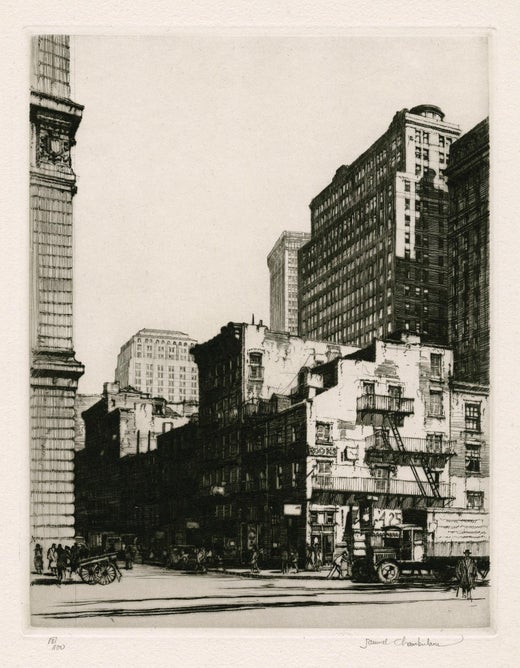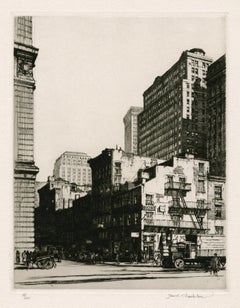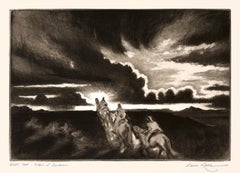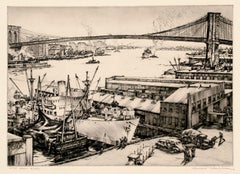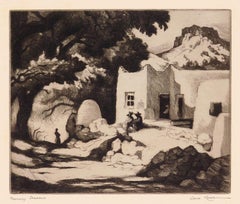Want more images or videos?
Request additional images or videos from the seller
1 of 3
Samuel Chamberlain'Soaring Steel' — Vintage Chicago Cityscape1929
1929
Price:$1,700
About the Item
- Creator:Samuel Chamberlain (1895-1975, American)
- Creation Year:1929
- Dimensions:Height: 12.25 in (31.12 cm)Width: 9.5 in (24.13 cm)
- Medium:
- Movement & Style:
- Period:
- Condition:
- Gallery Location:Myrtle Beach, SC
- Reference Number:Seller: 1033961stDibs: LU532313162142
Samuel Chamberlain
Samuel V. Chamberlain, printmaker, photographer, author, lecturer, and teacher was born in Cresco, Iowa on October 28, 1895. His family moved to Aberdeen, Washington in 1901 and, in 1913, Chamberlain enrolled in the University of Washington in Seattle where he studied architecture under Carl Gould. By 1915, he was enrolled in the School of Architecture of the Massachusetts Institute of Technology in Boston. With the United States' involvement in the First World War, Chamberlain sailed to France where he volunteered in the American Field Service. In 1918, he was transferred to the United States Army to complete his tour of duty. After the war, he returned to Boston and resumed his architectural studies, which he eventually discontinued and tried for a few years to work as a commercial artist. Chamberlain received the American Field Service Scholarship in 1923, which he used to travel in Spain, North Africa, and Italy. In 1924 he was living in Paris and in the spring he studied lithography with Gaston Dorfinant and in the autumn and winter months, he studied etching and drypoint with Edouard Léon. He published his first etching the following year. In 1927, he studied drypoint with Malcolm Osborne at the Royal College of Art in London. He taught part-time at the School of Architecture, University of Michigan, Ann Arbor; and the School of Architecture, Massachusetts Institute of Technology between his travels abroad. Chamberlain eventually settled for a dozen years in France. He authored and sometimes co-authored, with his wife Narcissa, Domestic Architecture of Rural France, Clementine in the Kitchen, New England Rooms 1639-1863, and Charleston Interiors. Chamberlain was a member of the American Academy of Arts and Sciences, the American Institute of Architects, the American Society of the French Legion of Honor, the Boston Camera Club, the Boston Printmakers, the Chicago Society of Etchers, Photographic Society of America, the Print Club of Albany, the Society of American Etchers, and was elected an Academician in the National Academy of Design. His work is represented in the collections of the Smithsonian American Art Museum, the Library of Congress, the Metropolitan Museum of Art, the Philadelphia Museum of Art, the National Academy Museum, the Harvard Art Museums, the Carnegie Museum of Art, the Museum of Fine Arts in Houston, the Museum of Fine Arts Boston, and the Nelson-Atkins Museum of Art. Samuel V. Chamberlain died in Marblehead, Massachusetts on January 10, 1975.
About the Seller
5.0
Recognized Seller
These prestigious sellers are industry leaders and represent the highest echelon for item quality and design.
Platinum Seller
Premium sellers with a 4.7+ rating and 24-hour response times
Established in 1995
1stDibs seller since 2016
321 sales on 1stDibs
Typical response time: 1 hour
Associations
International Fine Print Dealers Association
Authenticity Guarantee
In the unlikely event there’s an issue with an item’s authenticity, contact us within 1 year for a full refund. DetailsMoney-Back Guarantee
If your item is not as described, is damaged in transit, or does not arrive, contact us within 7 days for a full refund. Details24-Hour Cancellation
You have a 24-hour grace period in which to reconsider your purchase, with no questions asked.Vetted Professional Sellers
Our world-class sellers must adhere to strict standards for service and quality, maintaining the integrity of our listings.Price-Match Guarantee
If you find that a seller listed the same item for a lower price elsewhere, we’ll match it.Trusted Global Delivery
Our best-in-class carrier network provides specialized shipping options worldwide, including custom delivery.You May Also Like
Ancient Landscape II (Ancient City)
By Louise Nevelson
Located in Fairlawn, OH
Ancient Landscape II (Ancient City)
Etching and drypoint, 1953-55
Signed and titled in pencil by the artist (see photos)
Annotated: "E130 A/1" in pencil lower right
Estate stamp vers...
Category
1950s American Modern Landscape Prints
Materials
Drypoint
Ontario St. Grading and Temporary Ramps
By Louis Conrad Rosenberg
Located in Fairlawn, OH
Ontario St. Grading and Temporary Ramps
Drypoint, August 1929
Signed in pencil lower right (see photo)
From: The Cleveland Set (23 plates), this being No. 13
Edition: Small
A brilliant example of American industrial art. A wonderful, rich impression, with lots of burr and contrasts.
Louis Conrad Rosenberg
1890-1983
An American architectural etcher and engraver of the 1920's and 1930's era, Louis Conrad Rosenberg first studied at the Massachusetts Institute of Technology. He then enrolled at the Royal College of Art, London, to study etching techniques under Malcolm Osborne...
Category
1920s American Modern Landscape Prints
Materials
Drypoint
Cincinnati Union Terminal, Perspective From East
By Louis Conrad Rosenberg
Located in Fairlawn, OH
Cincinnati Union Terminal, Perspective From East
Drypoint, 1930-1931
Signed in pencil lower right (see photo)
Initialed and dated the the plate above the pencil signature
From: Cincinnati Series (8 Plates), this No. 2
Edition: 155, completed May 4, 1931
Delivered to Fellheimer & Wagner, 1931
Louis Conrad Rosenberg
1890-1983
An American architectural etcher and engraver of the 1920's and 1930's era, Louis Conrad Rosenberg first studied at the Massachusetts Institute of Technology...
Category
1930s American Modern Landscape Prints
Materials
Drypoint
Western Hills Viaduct Under Construction
By Louis Conrad Rosenberg
Located in Fairlawn, OH
Western Hills Viaduct Under Construction
Drypoint, June 1931
Signed in pencil lower right (see photo)
Initialed and dated in the plate lower right above pencil signature (see photo)
From: Cincinnati Series, 1930-1931, 8 plates, this No. 5
Small edition, not specified
From Greenfield Hill
Condition: Excellent
Image/Plate size: 8 1/2 x 15 1/4 inches
Sheet size: 11 1/4 x 18 1/2 inches
Louis Conrad Rosenberg
1890-1983
An American architectural etcher...
Category
1930s American Modern Landscape Prints
Materials
Drypoint
Victor DeWilde, The Anchor (San Francisco), 1930s
Located in New York, NY
Born in Tamines, Belgium, Victor DeWilde (1903-1977) settled in San Francisco around 1925. He studied at the California School of Fine Arts, SF, and California College of Arts & Crafts, Oakland. During the 1930s he taught at Commerce Evening High School and then worked on the WPA Art Education Program. His colleagues included Robert McChesney, Otis Oldfield, George Post...
Category
1930s American Modern Landscape Prints
Materials
Drypoint
Samuel Chamberlain, The Public Gaol, Williamsburg (Virginia)
By Samuel Chamberlain
Located in New York, NY
Samuel Chamberlain was a superb draftsman and his architectural images are often very complex. This image is, by contrast, quiet and understated: serene to the point of lonely. It's ...
Category
1930s American Modern Figurative Prints
Materials
Drypoint
Armin Landeck, Tenement Walls
By Armin Landeck
Located in New York, NY
The reference number on this work is Kraeft 88. It's from an edition of 100 and is signed, dated, and numbered, in pencil.
Always an intaglio printmaker, Landeck switched from a mor...
Category
Mid-20th Century American Modern Figurative Prints
Materials
Drypoint
A. Schultz, Riders in Central Park (New York City)
Located in New York, NY
Such an innovative image on the classic 'Riders in the Park' theme! Further, the use of drypoint and the rather direct -- even aggressive -- drawing style, bring it into the German E...
Category
1930s American Modern Landscape Prints
Materials
Drypoint
Bernard Sanders, Sledding in Central Park, NYC
Located in New York, NY
Signed in pencil. This scene is a hundred years old but if we have snow this year it can easily be recreated.
Category
Early 20th Century American Modern Landscape Prints
Materials
Drypoint
Werner Drewes, 125th Street at Broadway, NYC
By Werner Drewes
Located in New York, NY
Werner Drewes brought his modernist vision to this subject but created, in my opinion, a great work of the Etching Revival.
The reference is Rose 183. It...
Category
1930s American Modern Landscape Prints
Materials
Drypoint
More From This Seller
View All'Manhattan Old and New' — Vintage New York Cityscape
By Samuel Chamberlain
Located in Myrtle Beach, SC
Samuel Chamberlain, 'Manhattan Old and New', drypoint, 1929, edition 100, Chamberlain and Kingsland 81. Signed, titled, and numbered '81/100' in pencil. Titled and annotated '30.00' in pencil, in the artist's hand, bottom margin. Matted to museum standards, unframed.
A superb, finely-detailed impression, with selectively wiped plate tone, on heavy Rives cream wove paper; full margins (1 1/2 to 2 1/4 inches), in excellent condition.
The subject of the print is the lower Manhattan cityscape just before the Depression.
Image size 8 3/4 x 6 13/16 inches (222 x 173 mm); sheet size 12 3/4 x 10 inches (324 x 254 mm).
Impressions of this work are held in the collections of the National Gallery of Art and the Zimmerli Art Museum.
ABOUT THE ARTIST
'There is something about the atmospheric vibrancy of an etching which imparts a peculiar and irresistible life to architectural drawing...A copper plate offers receptive ground to the meticulously detailed drawing which so often appeals to the architect'. —Samuel Chamberlain, from the Catalogue Raisonné of his prints.
Samuel V. Chamberlain (1896 - 1975), printmaker, photographer, author, and teacher, was born in Iowa. His family moved to Aberdeen, Washington in 1901, and in 1913, Chamberlain enrolled in the University of Washington in Seattle, where he studied architecture under Carl Gould. By 1915, he was enrolled in the School of Architecture of the Massachusetts Institute of Technology in Boston. With the United States' involvement in the First World War, Chamberlain sailed to France, where he volunteered in the American Field Service. In 1918, he was transferred to the United States Army to complete his tour of duty. After the war, he returned to Boston and resumed his architectural studies, which he eventually discontinued, working for a few years as a commercial artist.
Chamberlain received the American Field Service Scholarship in 1923, which he used to travel to Spain, North Africa, and Italy. In 1924 he was living in Paris, where he studied lithography with Gaston Dorfinant and etching and drypoint with Edouard Léon, publishing his first etching the following year. In 1927, he studied drypoint with Malcolm Osborne...
Category
1920s American Modern Landscape Prints
Materials
Drypoint
'Riders at Sundown' — Mid-Century Southwest Regionalism
By Gene Kloss
Located in Myrtle Beach, SC
'Riders at Sundown', aquatint and drypoint, edition 75, 1953, Kloss 451. Signed, titled, and annotated 'Artist's Proof' in pencil. A superb, richly-inked, atmospheric impression, in ...
Category
1950s American Modern Landscape Prints
Materials
Drypoint, Aquatint
'The East River', Brooklyn Bridge — Mid-Century Realism, New York City
By Lawrence Wilbur
Located in Myrtle Beach, SC
Lawrence Nelson Wilbur (1897-1988), 'The East River', drypoint, edition 65, 1946. Signed, titled, and annotated 'A. Jones Proof 1946' in pencil. Signed and dated in the plate, lower ...
Category
1940s American Modern Landscape Prints
Materials
Drypoint
'Noonday Shadows' — Mid-Century Southwest Regionalism
By Gene Kloss
Located in Myrtle Beach, SC
'Noonday Shadows', etching and drypoint, edition 75, 1941, Kloss 376. Signed, and titled in pencil. A superb, richly inked impression, in warm black ink, on buff wove paper, in excel...
Category
1950s American Modern Landscape Prints
Materials
Drypoint, Etching
'Navajo Courtship Dance' — Southwest Regionalism, American Indian
By Ira Moskowitz
Located in Myrtle Beach, SC
Ira Moskowitz, 'Navajo Courtship Dance (Squaw Dance)', lithograph, 1946, edition 30, Czestochowski 161. Signed and titled in pencil. Signed and dated in the stone, lower left. A fine, richly-inked impression, on cream wove paper; the full sheet with margins (7/16 to 2 3/4 inches). Pale mat line, otherwise in excellent condition. Matted to museum standards, unframed.
Image size 11 13/16 x 14 13/16 inches (300 x 376 mm); sheet size 13 1/16 x 20 1/8 inches (332 x 511 mm).
ABOUT THE ARTIST
Ira Moskowitz was born in Galicia, Poland, in 1912, emigrating with his family to New York in 1927. He enrolled at the Art Student's League and studied there from 1928-31. In 1935, Moskowitz traveled to Paris and then lived until 1937 in what is now Israel. He returned to the United States in 1938 to marry artist Anna Barry in New York. The couple soon visited Taos and Santa Fe in New Mexico, returning for extended periods until 1944, when they moved there permanently, staying until 1949. During this especially productive New Mexico period, Moskowitz received a Guggenheim fellowship. His work was inspired by the New Mexico landscape and the state’s three cultures (American Southwest, Native American, and Mexican). He focused on Pueblo and Navajo life, producing an extensive oeuvre of authentic American Indian imagery. He and Anna also visited and sketched across the border in Old Mexico. While in the Southwest, Moskowitz flourished as a printmaker while continuing to produce oils and watercolors. Over 100 of Moskowitz’s works depicting Native American ceremonies were used to illustrate the book American Indian Ceremonial Dances by John Collier, Crown Publishers, New York, 1972.
After leaving the Southwest, printmaking remained an essential medium for the artist while his focus changed to subject matter celebrating Judaic religious life and customs. These works were well received early on, and Moskowitz was content to stay with them the rest of his life. From 1963 until 1966, Moskowitz lived in Paris, returning to New York City in 1967, where he made his permanent home until he died in 2001.
Shortly before his death, Zaplin-Lampert Gallery of Santa Fe staged an exhibition of the artist's works, December 2000 - January 2001. Other one-person shows included the 8th Street Playhouse, New York, 1934; Houston Museum, 1941; and the San Antonio Museum, 1941. The artist’s work was included in exhibitions at the Art Students League, Art Institute of Chicago, Philadelphia Print Club, College Art Association (promotes excellence in scholarship and teaching), and the International Exhibition of Graphic Arts (shown at MOMA, 1955).
Moskowitz’s lithographs of...
Category
1940s American Modern Landscape Prints
Materials
Lithograph
'Navajo Medicine Ceremony of the Night Chant' — Southwest Regionalism
By Ira Moskowitz
Located in Myrtle Beach, SC
Ira Moskowitz, 'The Three Gods of Healing (Navajo Medicine Ceremony of the Night Chant)', lithograph, 1945, edition 30, Czestochowski 148. Signed and titled in pencil. Signed and dated in the stone, lower right. A fine, richly-inked impression, on cream wove paper, with full margins (2 1/4 to 2 3/4 inches), in excellent condition. Matted to museum standards, unframed.
Image size 12 1/4 x 15 13/16 inches (311 x 402 mm); sheet size 17 1/8 x 20 7/8 inches (435 x 530 mm).
ABOUT THIS WORK
The nine-night ceremony known as the Night Chant or Nightway is believed to date from around 1000 B.C.E. when it was first performed by the Indians who lived in Canyon de Chelly (now eastern Arizona). It is considered the most sacred of all Navajo ceremonies and one of the most difficult and demanding to learn, as it encompasses hundreds of songs, dozens of prayers, and several highly complex sand paintings. And yet the demand for Night Chants is so great that as many as fifty such ceremonies might be held during a single winter season, which lasts eighteen to twenty weeks.
The Night Chant is designed both to cure people who are ill and to restore the order and balance of human and non-human relationships within the Navajo universe. Led by a trained medicine man who has served a long apprenticeship and learned the intricate and detailed practices that are essential to the chant, the ceremony itself is capable of scaring off sickness and ugliness through techniques that shock or arouse. Once the disorder has been removed, order and balance are restored through song, prayer, sand painting, and other aspects of the ceremony.
The medicine men who supervise the Night Chant ensure that everything—each dot and line in every sand painting, each verse in every song, each feather on each mask is arranged precisely, or it will not bring about the desired result. There are probably as many active Night Chant medicine men today as at any time in Navajo history due to the general increase in the Navajo population, the popularity of the ceremony, and the central role it plays in Navajo life and health.
ABOUT THE ARTIST
Ira Moskowitz was born in Galicia, Poland, in 1912, emigrating with his family to New York in 1927. He enrolled at the Art Student's League and studied there from 1928-31. In 1935, Moskowitz traveled to Paris and then lived until 1937 in what is now Israel. He returned to the United States in 1938 to marry artist Anna Barry in New York. The couple soon visited Taos and Santa Fe in New Mexico, returning for extended periods until 1944, when they moved there permanently, staying until 1949. During this especially productive New Mexico period, Moskowitz received a Guggenheim fellowship. His work was inspired by the New Mexico landscape and the state’s three cultures (American Southwest, Native American, and Mexican). He focused on Pueblo and Navajo life, producing an extensive oeuvre of authentic American Indian imagery. He and Anna also visited and sketched across the border in Old Mexico. While in the Southwest, Moskowitz flourished as a printmaker while continuing to produce oils and watercolors. Over 100 of Moskowitz’s works depicting Native American ceremonies were used to illustrate the book American Indian Ceremonial Dances by John Collier, Crown Publishers, New York, 1972.
After leaving the Southwest, printmaking remained an essential medium for the artist while his focus changed to subject matter celebrating Judaic religious life and customs. These works were well received early on, and Moskowitz was content to stay with them the rest of his life. From 1963 until 1966, Moskowitz lived in Paris, returning to New York City in 1967, where he made his permanent home until he died in 2001.
Shortly before his death, Zaplin-Lampert Gallery of Santa Fe staged an exhibition of the artist's works, December 2000 - January 2001. Other one-person shows included the 8th Street Playhouse, New York, 1934; Houston Museum, 1941; and the San Antonio Museum, 1941. The artist’s work was included in exhibitions at the Art Students League, Art Institute of Chicago, Philadelphia Print Club, College Art Association (promotes excellence in scholarship and teaching), and the International Exhibition of Graphic Arts (shown at MOMA, 1955).
Moskowitz’s lithographs of...
Category
1940s American Modern Landscape Prints
Materials
Lithograph
Recently Viewed
View AllMore Ways To Browse
James Swann
Jules Cavailles On Sale
Lichtenstein Haystack
Lightning Plane
Michael Schofield On Sale
Monet Signed Prints
Palestine Wall Art
Queensboro Bridge
R Marsh
Richard Devonshire
Rowland Langmaid
Sncf Dali
Spring Song Vintage Print
Thomas Moran Etching
Used Porta John
Valerie Thornton
Vintage United Airlines Travel Posters
William Stafford
